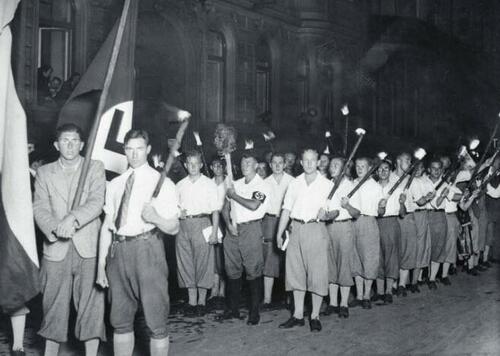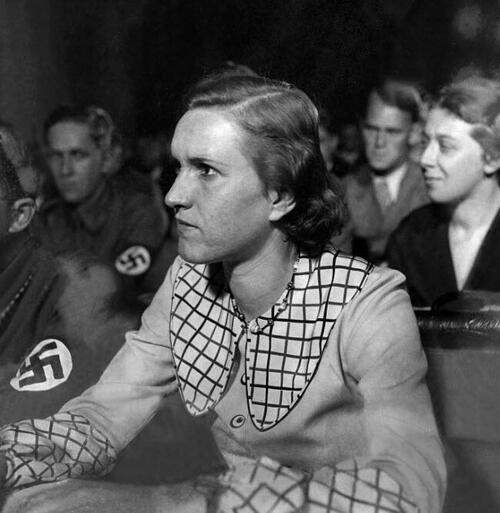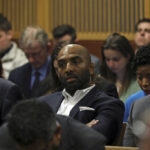
Authored by Niall Ferguson via The Free Press,
In 1927 the French philosopher Julien Benda published La trahison des clercs—“The Treason of the Intellectuals”—which condemned the descent of European intellectuals into extreme nationalism and racism. By that point, although Benito Mussolini had been in power in Italy for five years, Adolf Hitler was still six years away from power in Germany and 13 years away from victory over France. But already Benda could see the pernicious role that many European academics were playing in politics.
Those who were meant to pursue the life of the mind, he wrote, had ushered in “the age of the intellectual organization of political hatreds.” And those hatreds were already moving from the realm of the ideas into the realm of violence—with results that would be catastrophic for all of Europe.
A century later, American academia has gone in the opposite political direction—leftward instead of rightward—but has ended up in much the same place. The question is whether we—unlike the Germans—can do something about it.
Students at a public speaking school in the lecture hall of Berlin’s Humboldt University, c. 1931. (Photo by bpk/Salomon/ullstein bild via Getty Images)
For nearly ten years, rather like Benda, I have marveled at the treason of my fellow intellectuals. I have also witnessed the willingness of trustees, donors, and alumni to tolerate the politicization of American universities by an illiberal coalition of “woke” progressives, adherents of “critical race theory,” and apologists for Islamist extremism.
Throughout that period, friends assured me that I was exaggerating. Who could possibly object to more diversity, equity, and inclusion on campus? In any case, weren’t American universities always left-leaning? Were my concerns perhaps just another sign that I was the kind of conservative who had no real future in the academy?
Such arguments fell apart after October 7, as the response of “radical” students and professors to the Hamas atrocities against Israel revealed the realities of contemporary campus life. That hostility to Israeli policy in Gaza regularly slides into antisemitism is now impossible to deny.
I cannot stop thinking of the son of a Jewish friend of mine, who is a graduate student at one of the Ivy League colleges. Just this week, he went to the desk assigned to him to find, carefully placed under his computer keyboard, a note with the words “ZIONIST KIKE!!!” in red and green letters.
Just as disturbing as such incidents—and there are too many to recount—has been the dismally confused responses of university leaders.
Testifying before the House Committee on Education and the Workforce last week, Harvard President Claudine Gay, MIT President Sally Kornbluth, and University of Pennsylvania President Elizabeth Magill showed that they had been well-briefed by the lawyers their universities retain for such occasions.
They gave technically correct explanations of how First Amendment rules apply on their campuses—if they did apply. Yes, context matters. If all students did was chant “From the river to the sea,” that speech is protected, so long as there was no threat of violence or “discriminatory harassment.”
But the reason Claudine Gay’s carefully phrased answers on Tuesday infuriated her critics is not that they were technically incorrect, but that they were so clearly at odds with her record—specifically her record as dean of the Faculty of Arts and Sciences in the years 2018–2022, when Harvard was sliding to the very bottom of the rankings for free speech at colleges.
The killing of George Floyd happened when Gay was dean. Six days after Floyd’s death, she published a statement on the subject that suggests she felt personally threatened by events in distant Minneapolis. Floyd’s death, she wrote, illustrated “the brutality of racist violence in this country” and gave her an “acute sense of vulnerability.” She was “reminded, again, how even our [i.e., black Americans’] most mundane activities, like running. . . can carry inordinate risk. At a moment when all I want to do is gather my teenage son into my arms, I am painfully aware of how little shelter that provides.” In nothing that Gay said last Tuesday did she seem aware that Jewish students might have felt the same way after October 7.
In a memorandum to faculty on August 20, 2020, she wrote: “The calls for racial justice heard on our streets also echo on our campus, as we reckon with our individual and institutional shortcomings and with our Faculty’s shared responsibility to bring truth to bear on the pernicious effects of structural inequality.” Gay continued: “This moment offers a profound opportunity for institutional change that should not and cannot be squandered. . . . I write today to share my personal commitment to this transformational project and the first steps the FAS will take to advance this important agenda in the coming year.”
As the great German sociologist Max Weber rightly argued in his 1917 essay on “Science as a Vocation,” political activism should not be permissible in a lecture hall “because the prophet and the demagogue do not belong on the academic platform.” This was also the argument of the University of Chicago’s 1967 Kalven Report that universities must “maintain an independence from political fashions, passions, and pressures.”
This separation between scholarship and politics has been entirely disregarded at the major American universities in recent years. Instead, our most elite schools have embraced the kind of “institutional change” that Gay has championed. Look where it has led us.
* * *
It might be thought extraordinary that the most prestigious universities in the world should have been infected so rapidly with a politics imbued with antisemitism. Yet exactly the same thing has happened before.
A hundred years ago, in the 1920s, by far the best universities in the world were in Germany. By comparison with Heidelberg and Tübingen, Harvard and Yale were gentlemen’s clubs, where students paid more attention to football than to physics. More than a quarter of all the Nobel prizes awarded in the sciences between 1901 and 1940 were awarded to Germans; only 11 percent went to Americans. Albert Einstein reached the pinnacle of his profession not in 1933, when he moved to Princeton, but from 1914 to 1917, when he was appointed professor at the University of Berlin, director of the Kaiser Wilhelm Institute for Physics, and as a member of the Prussian Academy of Sciences. Even the finest scientists produced by Cambridge felt obliged to do a tour of duty in Germany.
Yet the German professoriat had a fatal weakness. For reasons that may be traced back to the foundation of the Bismarckian Reich or perhaps even further into Prussian history, academically educated Germans were unusually ready to prostrate themselves before a charismatic leader, in the belief that only such a leader could preserve the purity of the German nationalist project.
Today’s progressives engage in racism in the name of diversity. The nationalist academics of interwar Germany were at least overt about their desire for homogeneity and exclusion.
Marianne Weber recalled how, in the wake of the 1918 Revolution, her husband Max had explained his theory of democracy to the former supreme military commander, General Erich Ludendorff:
Weber: Do you think that I regard the Schweinerei that we now have as democracy?
Ludendorff: What is your idea of a democracy, then?
Weber: In a democracy, the people choose a leader whom they trust. Then the chosen man says, “Now shut your mouths and obey me.” The people and the parties are no longer free to interfere in the leader’s business.
Ludendorff: I should like such a “democracy.”
Weber: Later, the people can sit in judgment. If the leader has made mistakes—to the gallows with him!
Rudy Koshar’s study of the university town of Marburg in Hesse illustrates the way this culture led German academia toward the Nazis. The mainly Protestant student fraternities already excluded Jews from membership before World War I. In March 1920, in the turbulent aftermath of the revolution that had overthrown the imperial regime and established the Weimar Republic, a student paramilitary group was involved in a murderous attack on Communist workers. In the national elections held four years later, the Völkisch-Sozialer Bloc—of which the early Nazi Party (the NSDAP) was a key part—won 17.7 percent of the Marburg vote.
Lawyers and doctors, all credentialed with university degrees, were substantially overrepresented within the NSDAP, as were university students (then a far narrower section of society than today). To middle-aged lawyers, Hitler was the heir to Bismarck. For their sons, he was the Wagnerian hero Rienzi, the demagogue who unites the people of Rome.
Even a man who considered himself a liberal, as Max Weber surely did, was susceptible to the allure of charismatic leadership when the fledgling democracy seemed so weak. Three years after Weber’s death in 1920, Germany was plunged into disastrous hyperinflation. For many German academics, Hitler’s appointment as chancellor in January 1933 was a moment of national salvation.
“Right down to the last, deepest fiber in myself, I belong to the Führer and his wonderful movement,” wrote the Nazi lawyer Hans Frank in his diary after a concert he had attended with Hitler on February 10, 1937. “We are in truth God’s tool for the annihilation of the bad forces of the earth. We fight in God’s name against Jews and their Bolshevism. God protect us!” Such thoughts helped him and many other lawyers to come to terms with the systematic illegality that characterized the regime from the very outset.
German academics acted as Hitler’s think tank, putting policy flesh on the bones of his racist ideology. As early as 1920, the jurist Karl Binding and the psychiatrist Alfred Hoche published their Permission for the Destruction of Life Unworthy of Life, which sought to extrapolate from the annual cost of maintaining one “idiot” “the massive capital. . . being subtracted from the national product for entirely unproductive purposes.”
There is a clear line of continuity from this kind of analysis to the document found at the Schloss Hartheim asylum in 1945, which calculated that by 1951 the economic benefit of killing 70,273 mental patients—assuming an average daily outlay of 3.50 Reichsmarks and a life expectancy of ten years—would be 885,439,800 Reichsmarks. Many historians were little better, churning out tendentious historical justifications for German territorial claims in Eastern Europe that implied massive population displacement, if not genocide.
Students of the University of Berlin arrive at a book burning rally, 1933. (Photo via Getty Images)
A critical factor in the decline and fall of the German universities was precisely that so many senior academics were Jews. For some, Hitler’s antisemitism was therefore—not unlike woke intersectionality in our own time—a career opportunity.
For German academics of Jewish heritage, particularly those who had married gentiles and converted to Christianity, it was disorienting.
The case of Victor Klemperer, a convert to Christianity married to a gentile, is illustrative. A veteran of World War I, Klemperer was appointed Professor of Romance Languages and Literature at Dresden University of Technology in 1920. “I am nothing but a German or German European,” Klemperer wrote in his diary, one of the most illuminating testaments of the German Jewish nightmare. Throughout the 1930s, he maintained that it was the Nazis who were “un-German.” “I. . . feel shame for Germany,” he wrote after Hitler had come to power. “I have truly always felt German.”
Yet the atmosphere at German universities grew steadily more toxic even for the most assimilated of Jews.
In April 1933, under the Law for the Restoration of the Professional Civil Service, all Jewish civil servants, including judges, were removed from office, followed a month later by university lecturers. Klemperer recorded his agonized reaction in his diary:
March 10, 1933. . . . It is astounding how easily everything collapses. . . wild prohibitions and acts of violence. And with it, on streets and radio, never-ending propaganda. On Saturday. . . I heard a part of Hitler’s speech in Königsberg [the East Prussian university at which Immanuel Kant had spent his life]. . . I understood only a few words. But the tone! The unctuous bawling, truly bawling. . . . How long will I retain my professorship?
Klemperer managed to hang on to his chair for another two years. On May 2, 1935, however, the blow fell:
On Tuesday morning, without any previous notification—two sheets delivered by post. “On the basis of para 6 of the Law for the Restoration of the Professional Civil Service I have. . . recommended your dismissal.”. . . At first, I felt alternately dumb and slightly romantic; now there is only bitterness and wretchedness.
Five months later, to add insult to injury, he was barred from the university library reading room “as a non-Aryan.” What followed was a kind of relentless whittling away of his rights as a citizen.
The Nazis’ antisemitism led, of course, to one of the greatest brain drains in history. Over 200 of the country’s 800 Jewish professors departed, of whom twenty were Nobel laureates. Albert Einstein had already left in 1933 in disgust at Nazi attacks on his “Jewish physics.” The exodus quickened after the pogrom known as the Night of Broken Glass in November 1938. The principal beneficiaries of the Jewish brain drain were, of course, the universities of the United States.
Yet for Klemperer, emigration—least of all to Palestine, then a British “mandate” but also the location of the “national home for the Jewish people” promised by the British government in 1917—was out of the question. It would have been an admission that the Nazis were right: that he was in fact a Jew, not a German. As he put it: “If specifically Jewish states are now to be set up. . . that would be letting the Nazis throw us back thousands of years. . . . The solution to the Jewish question can be found only in deliverance from those who have invented it.”
It was this kind of reasoning that persuaded him and many other Jews to remain in Germany until it was no longer possible to get out. Some chose suicide—for example, the Marburg linguist Hermann Jacobsohn, who threw himself under a train. In the end, Klemperer avoided deportation to the death camps only because of the Royal Air Force bombing raid on Dresden in February 1945, which allowed him to shed his yellow star and lie low until the German surrender.
He remained in Dresden after the occupation of eastern Germany. It was not long before he began to notice resemblances between the language of the new Soviet-backed German Democratic Republic and the Third Reich. Like Hannah Arendt and George Orwell, Klemperer understood that the totalitarianism of the right and the totalitarianism of the left had fundamentally similar characteristics. In particular, they loved to impose Newspeak on those they subjugated.
* * *
Non-Jewish German academia did not just follow Hitler down the path to hell. It led the way. A few examples will suffice.
SS Oberführer Konrad Meyer, a professor of agronomy at the University of Berlin, was one of the experts who helped devise Heinrich Himmler’s “General Plan East” (Generalplan Ost) which, in the expectation of victory over the Soviet Union, was supposed to extend German settlement as far as Archangel in the north and Astrakhan in the south. Meyer’s version proposed establishing three vast “marcher settlements” with around five million German settlers. The fate of the peoples currently living there would be either annihilation or ethnic cleansing.
In 1940 a graduate student named Victor Scholz submitted a PhD thesis at the University of Breslau with the title “On the Possibilities of Recycling Gold from the Mouths of the Dead.”
He had carried out his research under the supervision of Professor Herman Euler, dean of the Breslau Medical Faculty.
At Auschwitz, SS Gruppenführer Carl Clauberg, a professor of gynecology at Königsberg, sought to find the most efficient way to sterilize women.
Among the techniques he experimented with was the injection, without anesthesia, of caustic substances into the uteruses of prisoners.
Anyone who has a naive belief in the power of higher education to instill ethical values has not studied the history of German universities in the Third Reich.
A university degree, far from inoculating Germans against Nazism, made them more likely to embrace it. The fall from grace of the German universities was personified by the readiness of Martin Heidegger, the greatest German philosopher of his generation, to jump on the Nazi bandwagon, a swastika pin in his lapel. He was a member of the Nazi Party from 1933 until 1945.
Later, after it was all over, the historian Friedrich Meinecke tried to explain “the German catastrophe” by arguing that excessive technical specialization had caused some educated Germans (not him, needless to say) to lose sight of the humanistic values of Goethe and Schiller. As a result, they had been unable to resist Hitler’s “mass Machiavellianism.”
The novelist Thomas Mann—who, unlike Meinecke, chose exile over complicity—was unusual in being able to recognize even at the time that, in “Brother Hitler,” the German educated elite possessed a monstrous younger sibling, whose role was to articulate and authorize their darkest aspirations.
A student at the University of Marburg, 1935. (Photo by ullstein bild/ullstein bild via Getty Images)
The lesson of German history for American academia should by now be clear. In Germany, to use the legalistic language of 2023, “speech crossed into conduct.” The “final solution of the Jewish question” began as speech—to be precise, it began as lectures and monographs and scholarly articles. It began in the songs of student fraternities. With extraordinary speed after 1933, however, it crossed into conduct: first, systematic pseudo-legal discrimination and ultimately, a program of technocratic genocide.
The Holocaust remains an exceptional historical crime—distinct from other acts of organized lethal violence directed against other minorities—precisely because it was perpetrated by a highly sophisticated nation-state that had within its borders the world’s finest universities. That is why American universities cannot regard antisemitism as just another expression of “hate,” no different from, say, Islamophobia—a neologism that should not be mentioned in the same breath. That is why Claudine Gay’s double standards—with their implication that African Americans are somehow more deserving of protection than Jews—are so indefensible.
That is why rational minds recoil from her argument that antisemitism on the Harvard campus is tolerable so long as genocide is not being perpetrated.
* * *
Well, the backlash against our contemporary treason of the intellectuals has finally arrived.
Donors such as the chief executive of Apollo, Marc Rowan (a Penn graduate), Pershing Square founder Bill Ackman (Harvard), and Stone Ridge founder Ross Stevens (Penn) have each made clear that their support will no longer be forthcoming for institutions run in this fashion.
On Saturday, Penn president Liz Magill stepped down, along with the chair of the Penn board of trustees, Scott Bok. Perhaps others will follow.
Yet it will take a lot more than a few high-profile resignations to reform the culture of America’s elite universities. It is much too entrenched in multiple departments, all dominated by a tenured faculty, to say nothing of the armies of DEI and Title IX officers who seem, at some colleges, now to outnumber the undergraduates.
In La trahison des clercs, Julien Benda accused the intellectuals of his time of dabbling in “the racial passions, class passions, and national passions. . . owing to which men rise up against other men.” Today’s academic leaders would never recognize themselves as the heirs of those Benda condemned, insisting that they are on the left, whereas Benda’s targets were on the right. And yet, as Victor Klemperer came to understand after 1945, totalitarianism comes in two flavors, though the ingredients are the same.
Only if the once-great American universities can reestablish—throughout their fabric—the separation of Wissenschaft from Politik can they be sure of avoiding the fate of Marburg and Königsberg.
Authored by Niall Ferguson via The Free Press,
In 1927 the French philosopher Julien Benda published La trahison des clercs—“The Treason of the Intellectuals”—which condemned the descent of European intellectuals into extreme nationalism and racism. By that point, although Benito Mussolini had been in power in Italy for five years, Adolf Hitler was still six years away from power in Germany and 13 years away from victory over France. But already Benda could see the pernicious role that many European academics were playing in politics.
Those who were meant to pursue the life of the mind, he wrote, had ushered in “the age of the intellectual organization of political hatreds.” And those hatreds were already moving from the realm of the ideas into the realm of violence—with results that would be catastrophic for all of Europe.
A century later, American academia has gone in the opposite political direction—leftward instead of rightward—but has ended up in much the same place. The question is whether we—unlike the Germans—can do something about it.
Students at a public speaking school in the lecture hall of Berlin’s Humboldt University, c. 1931. (Photo by bpk/Salomon/ullstein bild via Getty Images)
For nearly ten years, rather like Benda, I have marveled at the treason of my fellow intellectuals. I have also witnessed the willingness of trustees, donors, and alumni to tolerate the politicization of American universities by an illiberal coalition of “woke” progressives, adherents of “critical race theory,” and apologists for Islamist extremism.
Throughout that period, friends assured me that I was exaggerating. Who could possibly object to more diversity, equity, and inclusion on campus? In any case, weren’t American universities always left-leaning? Were my concerns perhaps just another sign that I was the kind of conservative who had no real future in the academy?
Such arguments fell apart after October 7, as the response of “radical” students and professors to the Hamas atrocities against Israel revealed the realities of contemporary campus life. That hostility to Israeli policy in Gaza regularly slides into antisemitism is now impossible to deny.
I cannot stop thinking of the son of a Jewish friend of mine, who is a graduate student at one of the Ivy League colleges. Just this week, he went to the desk assigned to him to find, carefully placed under his computer keyboard, a note with the words “ZIONIST KIKE!!!” in red and green letters.
Just as disturbing as such incidents—and there are too many to recount—has been the dismally confused responses of university leaders.
Testifying before the House Committee on Education and the Workforce last week, Harvard President Claudine Gay, MIT President Sally Kornbluth, and University of Pennsylvania President Elizabeth Magill showed that they had been well-briefed by the lawyers their universities retain for such occasions.
They gave technically correct explanations of how First Amendment rules apply on their campuses—if they did apply. Yes, context matters. If all students did was chant “From the river to the sea,” that speech is protected, so long as there was no threat of violence or “discriminatory harassment.”
But the reason Claudine Gay’s carefully phrased answers on Tuesday infuriated her critics is not that they were technically incorrect, but that they were so clearly at odds with her record—specifically her record as dean of the Faculty of Arts and Sciences in the years 2018–2022, when Harvard was sliding to the very bottom of the rankings for free speech at colleges.
The killing of George Floyd happened when Gay was dean. Six days after Floyd’s death, she published a statement on the subject that suggests she felt personally threatened by events in distant Minneapolis. Floyd’s death, she wrote, illustrated “the brutality of racist violence in this country” and gave her an “acute sense of vulnerability.” She was “reminded, again, how even our [i.e., black Americans’] most mundane activities, like running. . . can carry inordinate risk. At a moment when all I want to do is gather my teenage son into my arms, I am painfully aware of how little shelter that provides.” In nothing that Gay said last Tuesday did she seem aware that Jewish students might have felt the same way after October 7.
In a memorandum to faculty on August 20, 2020, she wrote: “The calls for racial justice heard on our streets also echo on our campus, as we reckon with our individual and institutional shortcomings and with our Faculty’s shared responsibility to bring truth to bear on the pernicious effects of structural inequality.” Gay continued: “This moment offers a profound opportunity for institutional change that should not and cannot be squandered. . . . I write today to share my personal commitment to this transformational project and the first steps the FAS will take to advance this important agenda in the coming year.”
As the great German sociologist Max Weber rightly argued in his 1917 essay on “Science as a Vocation,” political activism should not be permissible in a lecture hall “because the prophet and the demagogue do not belong on the academic platform.” This was also the argument of the University of Chicago’s 1967 Kalven Report that universities must “maintain an independence from political fashions, passions, and pressures.”
This separation between scholarship and politics has been entirely disregarded at the major American universities in recent years. Instead, our most elite schools have embraced the kind of “institutional change” that Gay has championed. Look where it has led us.
* * *
It might be thought extraordinary that the most prestigious universities in the world should have been infected so rapidly with a politics imbued with antisemitism. Yet exactly the same thing has happened before.
A hundred years ago, in the 1920s, by far the best universities in the world were in Germany. By comparison with Heidelberg and Tübingen, Harvard and Yale were gentlemen’s clubs, where students paid more attention to football than to physics. More than a quarter of all the Nobel prizes awarded in the sciences between 1901 and 1940 were awarded to Germans; only 11 percent went to Americans. Albert Einstein reached the pinnacle of his profession not in 1933, when he moved to Princeton, but from 1914 to 1917, when he was appointed professor at the University of Berlin, director of the Kaiser Wilhelm Institute for Physics, and as a member of the Prussian Academy of Sciences. Even the finest scientists produced by Cambridge felt obliged to do a tour of duty in Germany.
Yet the German professoriat had a fatal weakness. For reasons that may be traced back to the foundation of the Bismarckian Reich or perhaps even further into Prussian history, academically educated Germans were unusually ready to prostrate themselves before a charismatic leader, in the belief that only such a leader could preserve the purity of the German nationalist project.
Today’s progressives engage in racism in the name of diversity. The nationalist academics of interwar Germany were at least overt about their desire for homogeneity and exclusion.
Marianne Weber recalled how, in the wake of the 1918 Revolution, her husband Max had explained his theory of democracy to the former supreme military commander, General Erich Ludendorff:
Weber: Do you think that I regard the Schweinerei that we now have as democracy?
Ludendorff: What is your idea of a democracy, then?
Weber: In a democracy, the people choose a leader whom they trust. Then the chosen man says, “Now shut your mouths and obey me.” The people and the parties are no longer free to interfere in the leader’s business.
Ludendorff: I should like such a “democracy.”
Weber: Later, the people can sit in judgment. If the leader has made mistakes—to the gallows with him!
Rudy Koshar’s study of the university town of Marburg in Hesse illustrates the way this culture led German academia toward the Nazis. The mainly Protestant student fraternities already excluded Jews from membership before World War I. In March 1920, in the turbulent aftermath of the revolution that had overthrown the imperial regime and established the Weimar Republic, a student paramilitary group was involved in a murderous attack on Communist workers. In the national elections held four years later, the Völkisch-Sozialer Bloc—of which the early Nazi Party (the NSDAP) was a key part—won 17.7 percent of the Marburg vote.
Lawyers and doctors, all credentialed with university degrees, were substantially overrepresented within the NSDAP, as were university students (then a far narrower section of society than today). To middle-aged lawyers, Hitler was the heir to Bismarck. For their sons, he was the Wagnerian hero Rienzi, the demagogue who unites the people of Rome.
Even a man who considered himself a liberal, as Max Weber surely did, was susceptible to the allure of charismatic leadership when the fledgling democracy seemed so weak. Three years after Weber’s death in 1920, Germany was plunged into disastrous hyperinflation. For many German academics, Hitler’s appointment as chancellor in January 1933 was a moment of national salvation.
“Right down to the last, deepest fiber in myself, I belong to the Führer and his wonderful movement,” wrote the Nazi lawyer Hans Frank in his diary after a concert he had attended with Hitler on February 10, 1937. “We are in truth God’s tool for the annihilation of the bad forces of the earth. We fight in God’s name against Jews and their Bolshevism. God protect us!” Such thoughts helped him and many other lawyers to come to terms with the systematic illegality that characterized the regime from the very outset.
German academics acted as Hitler’s think tank, putting policy flesh on the bones of his racist ideology. As early as 1920, the jurist Karl Binding and the psychiatrist Alfred Hoche published their Permission for the Destruction of Life Unworthy of Life, which sought to extrapolate from the annual cost of maintaining one “idiot” “the massive capital. . . being subtracted from the national product for entirely unproductive purposes.”
There is a clear line of continuity from this kind of analysis to the document found at the Schloss Hartheim asylum in 1945, which calculated that by 1951 the economic benefit of killing 70,273 mental patients—assuming an average daily outlay of 3.50 Reichsmarks and a life expectancy of ten years—would be 885,439,800 Reichsmarks. Many historians were little better, churning out tendentious historical justifications for German territorial claims in Eastern Europe that implied massive population displacement, if not genocide.
Students of the University of Berlin arrive at a book burning rally, 1933. (Photo via Getty Images)
A critical factor in the decline and fall of the German universities was precisely that so many senior academics were Jews. For some, Hitler’s antisemitism was therefore—not unlike woke intersectionality in our own time—a career opportunity.
For German academics of Jewish heritage, particularly those who had married gentiles and converted to Christianity, it was disorienting.
The case of Victor Klemperer, a convert to Christianity married to a gentile, is illustrative. A veteran of World War I, Klemperer was appointed Professor of Romance Languages and Literature at Dresden University of Technology in 1920. “I am nothing but a German or German European,” Klemperer wrote in his diary, one of the most illuminating testaments of the German Jewish nightmare. Throughout the 1930s, he maintained that it was the Nazis who were “un-German.” “I. . . feel shame for Germany,” he wrote after Hitler had come to power. “I have truly always felt German.”
Yet the atmosphere at German universities grew steadily more toxic even for the most assimilated of Jews.
In April 1933, under the Law for the Restoration of the Professional Civil Service, all Jewish civil servants, including judges, were removed from office, followed a month later by university lecturers. Klemperer recorded his agonized reaction in his diary:
March 10, 1933. . . . It is astounding how easily everything collapses. . . wild prohibitions and acts of violence. And with it, on streets and radio, never-ending propaganda. On Saturday. . . I heard a part of Hitler’s speech in Königsberg [the East Prussian university at which Immanuel Kant had spent his life]. . . I understood only a few words. But the tone! The unctuous bawling, truly bawling. . . . How long will I retain my professorship?
Klemperer managed to hang on to his chair for another two years. On May 2, 1935, however, the blow fell:
On Tuesday morning, without any previous notification—two sheets delivered by post. “On the basis of para 6 of the Law for the Restoration of the Professional Civil Service I have. . . recommended your dismissal.”. . . At first, I felt alternately dumb and slightly romantic; now there is only bitterness and wretchedness.
Five months later, to add insult to injury, he was barred from the university library reading room “as a non-Aryan.” What followed was a kind of relentless whittling away of his rights as a citizen.
The Nazis’ antisemitism led, of course, to one of the greatest brain drains in history. Over 200 of the country’s 800 Jewish professors departed, of whom twenty were Nobel laureates. Albert Einstein had already left in 1933 in disgust at Nazi attacks on his “Jewish physics.” The exodus quickened after the pogrom known as the Night of Broken Glass in November 1938. The principal beneficiaries of the Jewish brain drain were, of course, the universities of the United States.
Yet for Klemperer, emigration—least of all to Palestine, then a British “mandate” but also the location of the “national home for the Jewish people” promised by the British government in 1917—was out of the question. It would have been an admission that the Nazis were right: that he was in fact a Jew, not a German. As he put it: “If specifically Jewish states are now to be set up. . . that would be letting the Nazis throw us back thousands of years. . . . The solution to the Jewish question can be found only in deliverance from those who have invented it.”
It was this kind of reasoning that persuaded him and many other Jews to remain in Germany until it was no longer possible to get out. Some chose suicide—for example, the Marburg linguist Hermann Jacobsohn, who threw himself under a train. In the end, Klemperer avoided deportation to the death camps only because of the Royal Air Force bombing raid on Dresden in February 1945, which allowed him to shed his yellow star and lie low until the German surrender.
He remained in Dresden after the occupation of eastern Germany. It was not long before he began to notice resemblances between the language of the new Soviet-backed German Democratic Republic and the Third Reich. Like Hannah Arendt and George Orwell, Klemperer understood that the totalitarianism of the right and the totalitarianism of the left had fundamentally similar characteristics. In particular, they loved to impose Newspeak on those they subjugated.
* * *
Non-Jewish German academia did not just follow Hitler down the path to hell. It led the way. A few examples will suffice.
SS Oberführer Konrad Meyer, a professor of agronomy at the University of Berlin, was one of the experts who helped devise Heinrich Himmler’s “General Plan East” (Generalplan Ost) which, in the expectation of victory over the Soviet Union, was supposed to extend German settlement as far as Archangel in the north and Astrakhan in the south. Meyer’s version proposed establishing three vast “marcher settlements” with around five million German settlers. The fate of the peoples currently living there would be either annihilation or ethnic cleansing.
In 1940 a graduate student named Victor Scholz submitted a PhD thesis at the University of Breslau with the title “On the Possibilities of Recycling Gold from the Mouths of the Dead.”
He had carried out his research under the supervision of Professor Herman Euler, dean of the Breslau Medical Faculty.
At Auschwitz, SS Gruppenführer Carl Clauberg, a professor of gynecology at Königsberg, sought to find the most efficient way to sterilize women.
Among the techniques he experimented with was the injection, without anesthesia, of caustic substances into the uteruses of prisoners.
Anyone who has a naive belief in the power of higher education to instill ethical values has not studied the history of German universities in the Third Reich.
A university degree, far from inoculating Germans against Nazism, made them more likely to embrace it. The fall from grace of the German universities was personified by the readiness of Martin Heidegger, the greatest German philosopher of his generation, to jump on the Nazi bandwagon, a swastika pin in his lapel. He was a member of the Nazi Party from 1933 until 1945.
Later, after it was all over, the historian Friedrich Meinecke tried to explain “the German catastrophe” by arguing that excessive technical specialization had caused some educated Germans (not him, needless to say) to lose sight of the humanistic values of Goethe and Schiller. As a result, they had been unable to resist Hitler’s “mass Machiavellianism.”
The novelist Thomas Mann—who, unlike Meinecke, chose exile over complicity—was unusual in being able to recognize even at the time that, in “Brother Hitler,” the German educated elite possessed a monstrous younger sibling, whose role was to articulate and authorize their darkest aspirations.
A student at the University of Marburg, 1935. (Photo by ullstein bild/ullstein bild via Getty Images)
The lesson of German history for American academia should by now be clear. In Germany, to use the legalistic language of 2023, “speech crossed into conduct.” The “final solution of the Jewish question” began as speech—to be precise, it began as lectures and monographs and scholarly articles. It began in the songs of student fraternities. With extraordinary speed after 1933, however, it crossed into conduct: first, systematic pseudo-legal discrimination and ultimately, a program of technocratic genocide.
The Holocaust remains an exceptional historical crime—distinct from other acts of organized lethal violence directed against other minorities—precisely because it was perpetrated by a highly sophisticated nation-state that had within its borders the world’s finest universities. That is why American universities cannot regard antisemitism as just another expression of “hate,” no different from, say, Islamophobia—a neologism that should not be mentioned in the same breath. That is why Claudine Gay’s double standards—with their implication that African Americans are somehow more deserving of protection than Jews—are so indefensible.
That is why rational minds recoil from her argument that antisemitism on the Harvard campus is tolerable so long as genocide is not being perpetrated.
* * *
Well, the backlash against our contemporary treason of the intellectuals has finally arrived.
Donors such as the chief executive of Apollo, Marc Rowan (a Penn graduate), Pershing Square founder Bill Ackman (Harvard), and Stone Ridge founder Ross Stevens (Penn) have each made clear that their support will no longer be forthcoming for institutions run in this fashion.
On Saturday, Penn president Liz Magill stepped down, along with the chair of the Penn board of trustees, Scott Bok. Perhaps others will follow.
Yet it will take a lot more than a few high-profile resignations to reform the culture of America’s elite universities. It is much too entrenched in multiple departments, all dominated by a tenured faculty, to say nothing of the armies of DEI and Title IX officers who seem, at some colleges, now to outnumber the undergraduates.
In La trahison des clercs, Julien Benda accused the intellectuals of his time of dabbling in “the racial passions, class passions, and national passions. . . owing to which men rise up against other men.” Today’s academic leaders would never recognize themselves as the heirs of those Benda condemned, insisting that they are on the left, whereas Benda’s targets were on the right. And yet, as Victor Klemperer came to understand after 1945, totalitarianism comes in two flavors, though the ingredients are the same.
Only if the once-great American universities can reestablish—throughout their fabric—the separation of Wissenschaft from Politik can they be sure of avoiding the fate of Marburg and Königsberg.
Loading…








